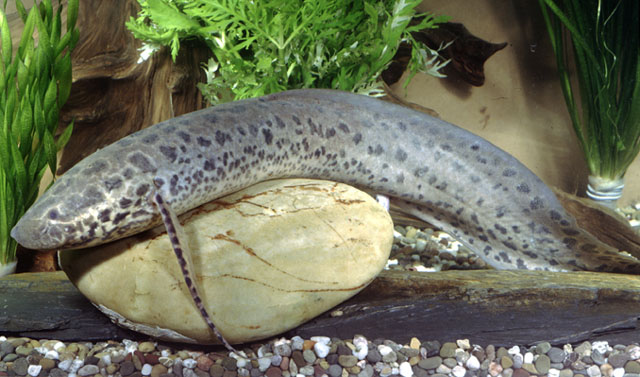| Protopteridae (African lungfishes) |
| 100 cm TL (male/unsexed); max.weight: 4,000.0 g |
|
demersal; freshwater, potamodromous |
| Africa: large Sahelian basins, Comoé River, Bandama River and some basins of Sierra Leone and Guinea (Protopterus annectens annectens) (Ref. 2834, 81261), upper Congo River, middle and lower Zambezi basin and all east coast rivers south to the Limpopo River (Ref. 3498, Ref. 13337), and Lake Rukwa (Ref. 13337) (Protopterus annectens brieni). Reports from the upper Cubango and Okavango system (Ref. 11970) unconfirmed (Ref. 52193, 120641). |
|
Diagnosis: Protopterus annectens annectens has an elongate body and paired fins are long and filamentous (Ref. 81261). The trunk, with 34-37 ribs, is a bit longer and the tail a bit shorter compared to Protopterus annectens brieni (Ref. 40587).
Description: Protopterus annectens annectens is characterized by an elongate body and a prominent snout (Ref. 2834, 81261). Eye small, its diameter comprised from 9 to 15 times in head length (Ref. 2834, 81261). Dorsal-fin origin closer to occiput than to anus; caudal fin pointed, but its tip often broken off; paired fins long and filamentous, the pectorals with a rather broad basal fringe, up to 3 times longer than the pelvic fins and up to twice longer than head (Ref. 367, 2834, 81261). External gills usually inserted behind the gill opening and above the anterior paired fin (Ref. 81261). Scales small, cycloid an embedded in the skin; 40-50 between gill opening and anus; 36-40 encircling the body in front of dorsal-fin origin (Ref. 2834, 3023, 81261).
Colouration: Usually dark, olivaceous or brownish, lighter below; irregular dark spots on fins and body, except on belly (Ref. 367, 81261). |
| Obligate air-breathing (Ref. 126274). Found in marginal swamps and backwaters of rivers and lakes (Ref. 30488). Carnivorous, food includes molluscs (Ref. 30488), but also frogs, fish and seed (Ref. 13851). In Kenya it feeds mostly on plant material, like roots (Ref. 30558). Strongly associated with life of aquatic plants in terms of breeding and feeding ecologies; nests are made in weedy areas (Ref. 30558). Normally lives on flood plains and secretes, when these dry up during the dry season, a thin slime around itself which dries into a fragile cocoon; normally hibernates from the end of one wet season to the start of the next, buut can live in its cocoon for over a year (Ref. 3023, 30558). For hibernating the fish literally chews its way into the substrate ejecting mud out of its gill openings, reaching a depth of 3-25 cm below the surface depending on the length of the fish; the lungfish wriggles around, thereby hollowing out a bulb-shaped chamber and coming to rest with its nose pointing upward; they breathe air at the mouth of the chamber's tube and then sink back into the expanded part of the chamber (Ref. 36739). As the water disappears the respiratory trips cease; air reaches the fish via the tube to the surface (Ref. 36739). Under aquatic conditions this lungfish can survive more than three and half years of starvation, showing the same behavior - no motion and same body posture - as an aestivating specimen (Ref. 51339). |
|
Least Concern (LC); Date assessed: 25 October 2019 Ref. (130435)
|
| harmless |
Source and more info: www.fishbase.org. For personal, classroom, and other internal use only. Not for publication.

